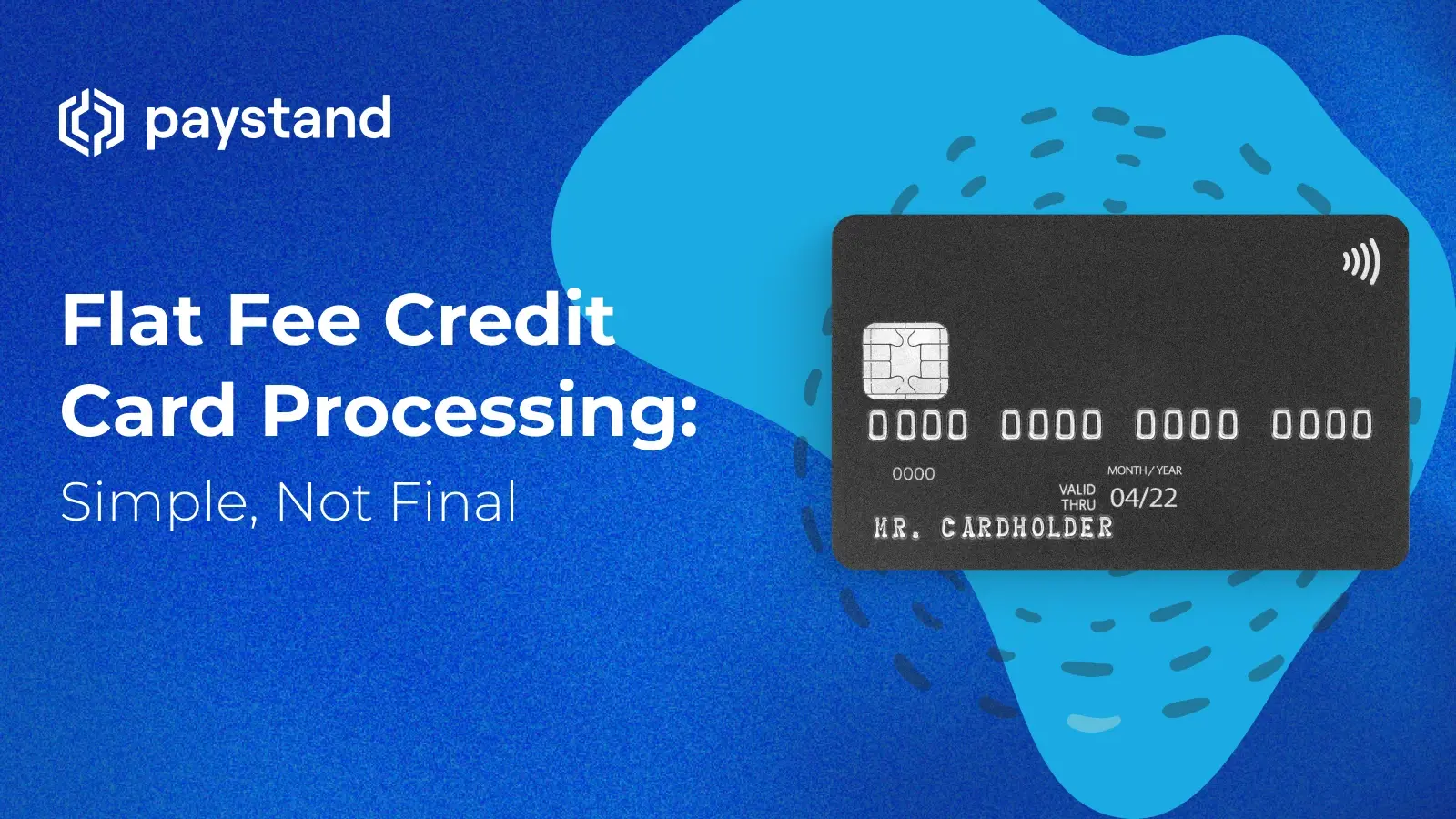Flat Fee Credit Card Processing: Simple, Not Final

Table of Contents
- What is flat fee credit card processing?
- What is a flat percentage?
- What is a flat rate fee or membership pricing?
- What is interchange?
- Who benefits from flat rate percentages?
- Why flat fee processing is not the final step
- The financial revolution is here
Key Takeaways
- Flat fee credit card processing simplifies payments with one predictable rate, making it a popular choice for small and growing businesses.
- While flat rates offer transparency, they often include padded costs that don’t necessarily translate to long-term savings.
- Subscription-based models like membership pricing provide more control and cost visibility, but still tie businesses to interchange fees.
- As transaction volumes grow, flat rates may fall short, especially for B2B companies benefitting from more strategic, fee-reducing alternatives.
- Platforms like Paystand offer zero-fee payment rails and blockchain infrastructure, helping businesses escape legacy systems.
When accepting credit cards, most businesses aren’t asking for miracles; they just want a pricing structure that’s easy to understand, free of hidden charges, and fair. That’s exactly why flat fee credit card processing has become so popular. Flat-rate payments offer a rare gift: predictability in a landscape of opaque statements and fluctuating charges.
For small businesses, startups, and growing companies dipping their toes into digital payments, the idea of a fixed percentage fee makes budgeting easier and reconciliation less painful. There’s no deciphering which card brands carry higher interchange fees or wondering why a transaction that looked identical to yesterday’s now costs more: one flat rate, one consistent experience.
As finance teams grow savvier and technology evolves, a bigger question arises: What if “simple” isn’t enough? If your payment processor provides ease without efficiency, clarity without cost control, then flat fees may mark the start, not the end, of your payment evolution.
What Is Flat Fee Credit Card Processing?
At its core, flat fee credit card processing means your business pays the same fee every time you accept a credit card, regardless of card type or transaction size. That usually means a fixed percentage, possibly with a small per-transaction fee. You could process a basic debit or premium rewards card and still pay the same rate.
This pricing structure is a big deal for businesses tired of variable credit card processing fees. It eliminates the need to analyze complex interchange tables or track how much processors charge for each type of card, which is a massive time saver for businesses with limited accounting resources.
What Is a Flat Percentage?
A flat percentage is the consistent fee applied to every transaction. Instead of different rates depending on whether a transaction is swiped, keyed, or processed online, or depending on the card type, you pay one fixed rate.
Let’s say your processor charges 2.75%. If you run a $100 transaction, your fee is always $2.75. This is easy to calculate and forecast, making flat-rate credit card processing attractive to small business owners. It replaces complexity with clarity.
But behind that flat rate is a bundle of costs: interchange, network fees, processor markup, and more. Your flat percentage is padded to cover the most expensive scenario. That means you’re still paying a high fixed rate when the underlying interchange fee is low.
So while flat fees are transparent, they’re not always optimized for savings.
What Is a Flat Rate Fee or Membership Pricing?
Some processors take flat pricing a step further with membership pricing, also called subscription or wholesale pricing. In this model, your business pays a monthly fee (e.g., $99/month) for access to the true interchange fees plus a very small fixed markup per transaction.
This model separates the payment processor’s profit from the transaction itself, giving businesses greater visibility into how much they pay and why. It’s an attractive option for companies that process large transactions and want to avoid the markup baked into standard flat rates.
However, membership pricing still ties you to credit card networks and associated costs. You’re still paying interchange, and depending on your processor or location, you may face convenience fees or restrictions on passing credit card fees to customers.
So while this model gives you more control, it doesn’t necessarily solve the bigger challenge: how to escape credit card processing fees altogether.
What Is Interchange?
Every time your business processes a credit card transaction, a portion of the fee goes to the card-issuing bank. This is called the interchange fee, and card networks like Visa and Mastercard set it.
Interchange rates vary based on many factors, including whether the card is credit or debit, whether the customer is in-person or online, the merchant’s industry, and more. For example, premium rewards cards typically carry higher interchange fees, which the merchant is expected to absorb.
That variability is exactly why flat rate models exist: to eliminate the unpredictability of interchange-based pricing. When you use a flat rate, you’re often paying more than the actual interchange cost just for the sake of simplicity.
Flat fees may simplify things, but they don’t eliminate the underlying costs or inefficiencies. They merely wrap them into a predictable (often padded) package.
Who Benefits from Flat Rate Percentages?
Flat rate processing isn’t a one-size-fits-all solution, but it’s a great fit for many businesses, especially those just starting or managing modest transaction volumes.
If your business processes less than $10,000 monthly, flat rate fees can help you avoid overthinking your credit card processor relationship. You get to accept credit cards quickly, with minimal setup, and you won’t be hit with confusing transaction fees or tiered pricing schemes.
Flat rate pricing also makes life easier for business owners with limited accounting support. When every dollar and minute counts, flat fees help streamline budgeting and monthly reconciliation.
However, flat rates may become less advantageous as your business grows, especially in B2B payments. High-volume merchants can unlock significant savings by transitioning to more strategic payment platforms that eliminate unnecessary fees.
Why Flat Fee Processing Is Not the Final Step
Flat fees solved a real problem: they made credit card processing easier to understand. For too long, processors charged merchants using a dizzying mix of tiered pricing, hidden surcharges, and obscure rules. Flat rates brought structure and sanity to that chaos.
But flat rates still operate within the same old system. They’re just a cleaner way to navigate it. The real innovation comes when you move beyond the system entirely.
Imagine a world where you don’t just reduce card fees, but eliminate them. Payments aren’t routed through legacy card networks; they flow directly, instantly, and cost-free via blockchain infrastructure. You don’t have to worry about convenience fees and surcharges because your platform is built for openness, not overhead.
That’s the next phase of payments, and it’s already here.
Beyond Flat: How Paystand Reinvents Payment Processing
Paystand offers a 1.99% flat rate for credit card processing, but here’s what makes it different: we believe the fee should be zero. And with our platform, it can be.
By giving businesses access to a fee-free B2B payment network, Paystand eliminates the need for card-based payments. You can still accept cards when needed, but our infrastructure is designed to reroute payments through faster, cheaper, and more intelligent rails.
Here’s how your business benefits:
- Zero-fee bank payments that bypass card networks entirely
- Smart tools to pass credit card fees to customers compliantly
- Automated reconciliation inside your ERP
- Full visibility into every pricing structure and transaction fee
- Secure, blockchain-based rails that reduce fraud and settlement times
We’re lowering fees and helping businesses regain control over their cash cycle and finances.
The Financial Revolution Is Here
Legacy systems were built before the Internet. They weren’t designed for modern business, real-time payments, or decentralized technology. Flat fee processing helped businesses make peace with these outdated systems, but now it’s time to challenge them.
Blockchain, smart contracts, AI-driven automation, and digital payments aren’t theoretical anymore; they’re how leading companies manage their money. And if you haven’t moved into the new wave, here’s how. It's your chance to change things.
Reimagine possibilities. Challenge assumptions. If you're ready to own your infrastructure instead of renting the financial system, check our Fees & Incentives to get started.






